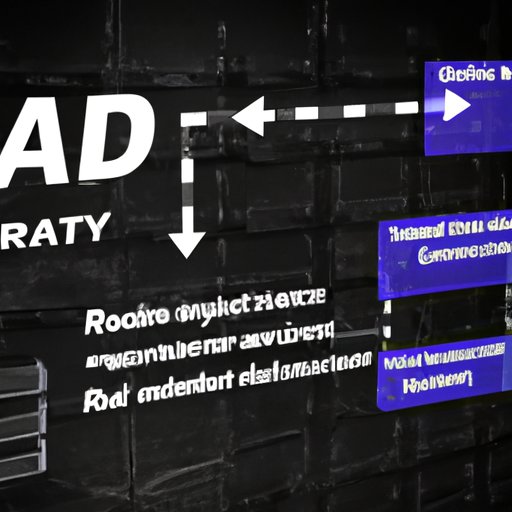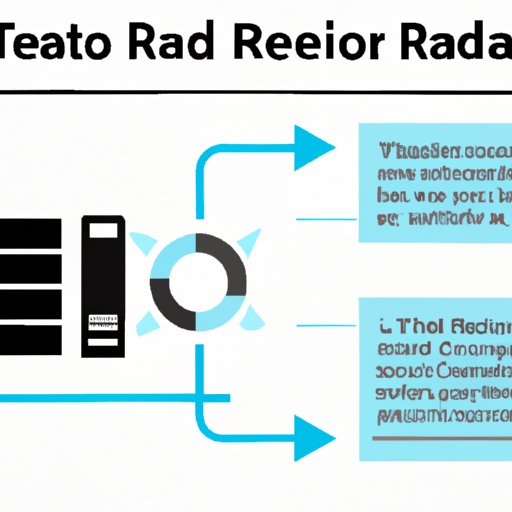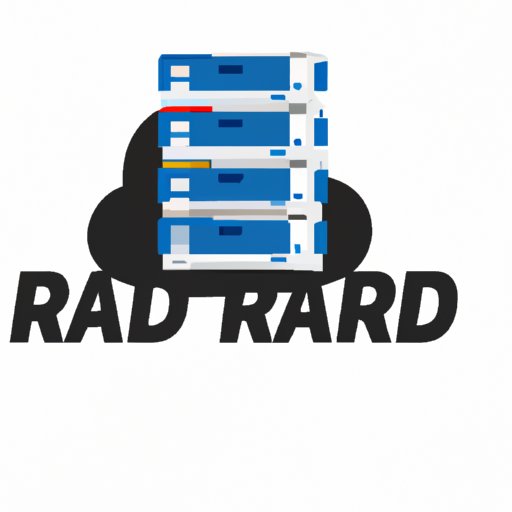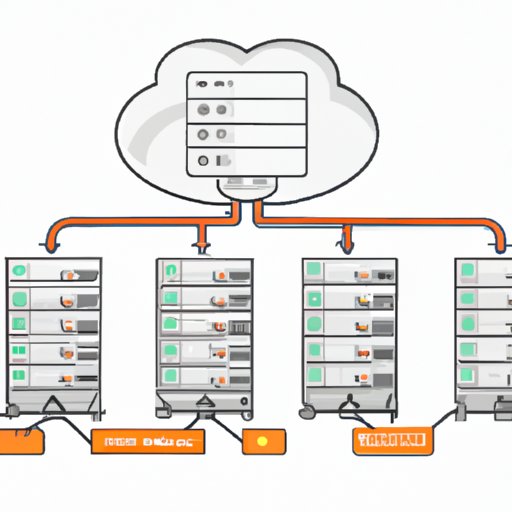Introduction
RAID, or Redundant Array of Independent Disks, is a type of data storage technology that combines multiple physical disk drive components into one logical unit. It has become increasingly popular in recent years due to its ability to increase storage capacity, improve performance, and provide fault tolerance – meaning that if one disk fails, the data on all other disks is still accessible. In this article, we will explore what RAID technology is and how it can benefit businesses. We will also discuss different RAID levels and configurations, as well as the factors that affect RAID performance and reliability.
A Guide to RAID Technology: What Is It and How Does It Work?
RAID technology was first developed in 1987 at the University of California, Berkeley and has since become a widely used storage solution for both personal and business use. RAID technology allows multiple hard drives to be connected and configured to work together as one unit, providing increased storage capacity and performance, as well as fault tolerance. RAID technology is implemented by combining multiple smaller disks into a single array, which is then treated as a single storage device.

Overview of RAID Technology
RAID technology is based on the concept of redundancy, which is the practice of storing multiple copies of data in different locations to ensure that the data can still be accessed in case of a failure. RAID technology uses a combination of mirroring and striping techniques to create a redundant array of independent disks, where each disk contributes to the overall performance of the system. Mirroring involves copying data from one disk to another, while striping involves breaking up data into small chunks and distributing it across multiple disks. The combination of these two techniques allows for increased storage capacity, improved performance, and fault tolerance.
Types of RAID
There are several types of RAID configurations available, each with its own set of benefits and drawbacks. The most common types of RAID are RAID 0, RAID 1, RAID 5, RAID 6, and RAID 10. Each type of RAID offers different levels of performance, storage capacity, and fault tolerance.

RAID Technology: An Overview of Its Uses and Benefits
RAID technology is used by businesses to store large amounts of data in a cost-effective and reliable way. It can be used to create redundant backups of important data, as well as to increase storage capacity and performance. RAID technology also provides fault tolerance, meaning that if one disk fails, the data on all other disks is still accessible. RAID technology is also used to improve the speed and reliability of systems by spreading out data processing tasks across multiple disks.
Benefits of RAID Technology
The main benefits of RAID technology include increased storage capacity, improved performance, and fault tolerance. RAID technology can also improve the speed and reliability of systems by spreading out data processing tasks across multiple disks. Additionally, RAID technology can reduce the risk of data loss in the event of a hardware failure or power outage. Finally, RAID technology can also provide better security for sensitive data by encrypting the stored data.
Common Applications for RAID
RAID technology is used in a variety of applications, including servers, databases, video editing, and gaming. RAID technology is also commonly used in cloud computing, virtualized environments, and storage area networks (SANs). RAID technology is also used in consumer electronics such as external hard drives, digital video recorders (DVRs), and network-attached storage (NAS) devices.
Exploring RAID: The Basics of Redundant Array of Independent Disks
RAID stands for Redundant Array of Independent Disks. It is a type of data storage technology that combines multiple physical disk drive components into one logical unit. RAID technology uses a combination of mirroring and striping techniques to create a redundant array of independent disks, where each disk contributes to the overall performance of the system.
Basics of RAID
RAID technology is based on the concept of redundancy, which is the practice of storing multiple copies of data in different locations to ensure that the data can still be accessed in case of a failure. RAID technology is implemented by combining multiple smaller disks into a single array, which is then treated as a single storage device. The array can be configured in different ways, depending on the desired level of performance, storage capacity, and fault tolerance.
Different RAID Configurations
There are several types of RAID configurations available, each with its own set of benefits and drawbacks. The most common types of RAID are RAID 0, RAID 1, RAID 5, RAID 6, and RAID 10. Each type of RAID offers different levels of performance, storage capacity, and fault tolerance.

RAID Storage Solutions for Businesses
RAID storage solutions are becoming increasingly popular among businesses due to their ability to provide increased storage capacity and improved performance. RAID storage solutions can also provide more reliable data protection, as they are designed to protect against hardware failures and power outages. Additionally, RAID storage solutions can provide better security for sensitive data by encrypting the stored data.
Advantages of RAID in Business
RAID storage solutions offer many advantages for businesses. For example, they can increase storage capacity, improve performance, and provide fault tolerance. Additionally, RAID storage solutions can reduce the risk of data loss due to hardware failure or power outages. Finally, RAID storage solutions can also provide better security for sensitive data by encrypting the stored data.

RAID Levels and Their Advantages
There are several types of RAID levels available, each with its own set of benefits and drawbacks. The most common types of RAID are RAID 0, RAID 1, RAID 5, RAID 6, and RAID 10. Each type of RAID offers different levels of performance, storage capacity, and fault tolerance.
RAID 0
RAID 0, also known as striping, is a type of RAID configuration that is used to increase storage capacity and performance. RAID 0 splits data across multiple disks, which improves performance by allowing multiple requests to be processed simultaneously. However, RAID 0 does not provide any fault tolerance, meaning that if one disk fails, all data on all disks is lost.
RAID 1
RAID 1, also known as mirroring, is a type of RAID configuration that is used to provide fault tolerance. RAID 1 creates a copy of data on two or more disks, which ensures that the data is still accessible even if one disk fails. RAID 1 also increases performance, as read requests can be processed from either disk. However, RAID 1 requires twice as much storage capacity as RAID 0.
RAID 5
RAID 5 is a type of RAID configuration that is used to increase storage capacity and provide fault tolerance. RAID 5 uses striping and parity, which is a technique of creating a “check” for the data stored on the disks. This check ensures that the data can still be accessed in the event of a disk failure. RAID 5 also increases performance, as multiple requests can be processed simultaneously.
RAID 6
RAID 6 is similar to RAID 5, but it uses double parity instead of single parity. This means that RAID 6 can withstand the failure of two disks, making it more reliable than RAID 5. RAID 6 also increases storage capacity and performance, but it requires more disks than RAID 5.
RAID 10
RAID 10 is a type of RAID configuration that combines mirroring and striping. RAID 10 uses a combination of RAID 0 and RAID 1, which increases performance and provides fault tolerance. RAID 10 also increases storage capacity, but it requires more disks than RAID 5 or RAID 6.
Understanding RAID Performance and Reliability
RAID performance and reliability are affected by several factors, including the type of RAID configuration used, the number of disks used, and the size of the disks. Additionally, RAID performance and reliability can be impacted by the type of controller used and the quality of the disks. To ensure optimal performance and reliability, businesses should use high-quality disks and controllers.
Factors Affecting RAID Performance
Several factors can affect RAID performance, including the type of RAID configuration used, the number of disks used, the size of the disks, and the type of controller used. Additionally, RAID performance can be impacted by the quality of the disks, as low-quality disks may cause bottlenecks that reduce overall performance.
RAID Reliability
The reliability of a RAID setup is determined by the type of RAID configuration used, the number of disks used, and the quality of the disks. RAID configurations that use mirroring and parity, such as RAID 5 and RAID 6, are generally more reliable than configurations that do not use these techniques. Additionally, using high-quality disks and controllers can help improve the reliability of a RAID setup.
RAID Configurations: Choosing the Right Setup for Your Needs
When choosing a RAID configuration, businesses should consider their storage needs, budget, and desired level of performance, storage capacity, and fault tolerance. Additionally, businesses should consider the type of controller and quality of disks they are using, as these factors can have a significant impact on RAID performance and reliability. Depending on the organization’s needs, RAID 0, RAID 1, RAID 5, RAID 6, or RAID 10 may be the best option.
Considerations When Choosing a RAID Configuration
When choosing a RAID configuration, businesses should consider their storage needs, budget, and desired level of performance, storage capacity, and fault tolerance. Additionally, businesses should consider the type of controller and quality of disks they are using, as these factors can have a significant impact on RAID performance and reliability.

Choosing the Right RAID Setup for Your Organization
The right RAID setup for an organization depends on its storage needs, budget, and desired level of performance, storage capacity, and fault tolerance. Organizations should consider their options carefully and choose a RAID configuration that best meets their needs. Additionally, organizations should use high-quality disks and controllers to ensure optimal performance and reliability.
Conclusion
RAID technology is a type of data storage technology that combines multiple physical disk drive components into one logical unit. It is used to increase storage capacity, improve performance, and provide fault tolerance. There are several types of RAID configurations available, each with its own set of benefits and drawbacks. Additionally, RAID performance and reliability can be impacted by the type of controller and quality of disks used. When choosing a RAID configuration, businesses should consider their storage needs, budget, and desired level of performance, storage capacity, and fault tolerance.
(Note: Is this article not meeting your expectations? Do you have knowledge or insights to share? Unlock new opportunities and expand your reach by joining our authors team. Click Registration to join us and share your expertise with our readers.)
